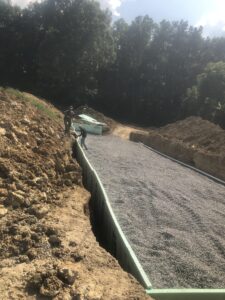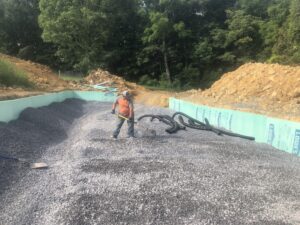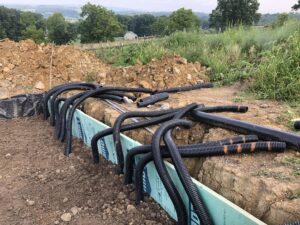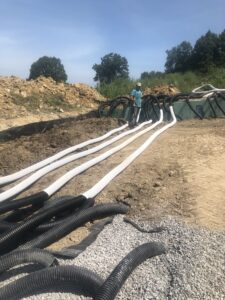Final report for FNE20-962
Project Information
High tunnel temperature control is critical to year-round crop growth; yet can be both challenging and expensive. The objective of this study was to develop a cost-effective self-sustaining temperature moderation system for large (defined as 30ft by 96ft) high tunnels utilizing a geothermal system, powered by a configuration of solar panels, wind turbine and batteries with electric backup to energize fans that will circulate moderating air into the high tunnel from geothermal piping.
After some initial experimentation, we installed within the geothermal high tunnel four high speed fans powered by twelve solar panels, a wind turbine and six 200Ah hybrid gel batteries with an electrical backup. Component adjustments were made throughout the project. Temperature data inside the geothermal high tunnel and a second “control” high tunnel were collected during designated winter months in 2020 and 2021 when the temperature in a control non-geothermal second high tunnel was below 40 degrees. Data during the summer months was collected from the four manifolds vents within the geothermal high tunnel and a central location away from the manifold vents within the geothermal high tunnel. Data was also documented on estimated cost of materials and operation for three possible options for farmers who wish to grow year-round crops: 1. Cost of propane/natural gas heating systems with fuel (no summer cooling/air circulation with this option), 2. Cost of geothermal network that is not self-sustaining (powered solely by electricity) and 3. Cost of a self-sustaining geothermal high tunnel powered by solar and wind energy system with electrical or battery charger backup. Upon completion of testing, an analysis of the temperature moderation and relative cost data was made.
As noted, we evaluated whether this system could support year-round plant growth including during extreme hot and cold temperatures. We found that the system was effective during the winter months to help warm the high tunnel to temperatures above freezing when a second "control high tunnel" temperatures were 22 degrees or above and maintained the geothermal high tunnel at least ten degrees warmer than the "control high tunnel" when temperatures were below 22 degrees. In cases where we anticipated severe temperatures below 22 degrees in the control high tunnel, we were able to protect our crops using the geothermal warming and Agri-bon frost protection fabric. We also had to determine the optimum fan speed to blow air through the geothermal pipes fast enough to heat the high tunnel but without increasing the velocity of the air too fast resulting in loss of warmth from the ground surrounding the pipes. We also conducted research on the effect of geothermal system in the summer but quickly found that there was no way to accurately measure the temperature differential because the high tunnel side curtains were required to be open to prevent the solar effect from the sun from overheating the high tunnel. We did determine, however, that the air emanating from the pipes in the geothermal high tunnel was significantly cooler then the temperature within the high tunnel itself, demonstrating cool air was being added to the high tunnel. We also found that the fans were helpful in circulating the air within the high tunnel, thus preventing air stagnation.
Finally, we found that a solar system with batteries and to a much lesser extent, wind energy system with batteries, are useful as power sources for the fans needed in a geothermal high tunnel. Of course, on grid electricity can also power the fans should the farmer have access to the electric grid and not want to use alternative energy to power the fans.
This project was publicized through presentations, farm visits, and internet videos and postings.
This project seeks to discover if a geothermal high tunnel powered by self-sustaining solar/wind energy is a viable option for farmers wanting to farm year-round in climates susceptible to extreme hot and cold temperatures. In studying this objective, this project seeks to determine the following:
- Whether a self-sustaining geothermal solar/wind energy system can “sufficiently heat” a geothermal high tunnel when the control high tunnel temperatures are below 40 degrees without a supplemental heat source such as natural gas. “Sufficiently heat” is defined as maintaining the geothermal high tunnel temperature above freezing at night when the control high tunnel temperature is 22 degrees or above; and maintaining the geothermal high tunnel temperature at least ten degrees higher when the control high tunnel temperature is below 22 degrees. Note that night control high tunnel temperatures should equate to outside temperatures.
- Whether a self-sustaining geothermal solar/wind energy system can “sufficiently cool” a high tunnel during temperatures above 75 degrees with side curtains closed and if so, can it do so for extended periods during the hot summer months in West Virginia. “Sufficiently cool” is defined as maintaining the temperature in the geothermal high tunnel at 75 degrees.
- The optimum design configuration for such a system in terms of solar, wind turbine and battery interface and electrical backup.
- The relative materials and operating costs of traditional geothermal, self-sustaining geothermal, and natural gas/propane systems both in start-up and annual operating costs.
- Whether the sides of a high tunnel should be open or closed when cooling the high tunnel in the summer using geothermal energy.
- The optimum fan air velocities (measured as cubic feet per minute) in the underground pipes to effectively transmit and moderate the heating and cooling in a large high tunnel.
High tunnel temperature control is critical to year-round and specialty crop growth; yet it is challenging and expensive. Currently, farmers utilize natural gas/propane, wood burning stoves, oil furnaces, electric heat, low tunnels using Agri-bon fabric, and in some locations geothermal systems to provide additional heat to high tunnels beyond the effects of passive solar heating. For cooling and air circulation, farmers use fans and evaporative cooling systems and for ventilation, they use end vents, side curtains and roof vents to release heat from the high tunnels and circulate air. None of the common active heating and cooling systems are self-sustaining, i.e. all require expenditure of an external energy source and some have additional labor costs. In addition, while ventilation can be self-sustaining and will provide limited heat relief during hot summer days, a geothermal system will dispense and circulate cool air in and around the high tunnel.
During a 2019 tour of our farm, Dr. Lewis Jett from WVU indicated that he is unaware of any geothermal high tunnels in West Virginia and has a strong interest in our project.
Geothermal systems powered by wind/solar energy can heat and cool high tunnels with virtually no maintenance and negligible additional cost after system installation. One of the outcomes of this project is to determine if geothermal systems provide the best option for farmers wishing to grow year-round in areas that experience extreme hot and cold temperatures. The project will examine whether a geothermal system can sufficiently heat a large (30 ft by 96 ft) high tunnel during weather below 40 degrees for several days without a supplemental heat source such as natural gas. In addition, the project will provide data and analysis on whether it is functionally and economically feasible to power a geothermal high tunnel with self-sustaining solar/wind energy. With this information farmers can determine if they wish to utilize traditional heat sources such as the burning of gas or wood, a traditional geothermal system utilizing the electric grid to power the fans, or a self-sustaining geothermal system utilizing solar and wind. For farmers who require cooling during the summer to protect heat sensitive crops, this project will also provide data and analysis to determine if geothermal cooling will contribute to cooling a high tunnel during hot weather extremes (temperature above 75 degrees). It will also determine whether the side curtains should be open or closed while the geothermal system is circulating the cool air.
If a self-sustaining system can be developed, farmers without access to the electrical grid can farm year-round. Moreover, farmers with access to the grid may decide to forgo the energy costs of on-grid electricity and go off grid. While there is much research and understanding about how much energy a solar panel can generate in various areas of the country, there is little or no research as to optimum solar/wind turbine battery design necessary to power geothermal/climate battery high tunnel fans in winter months when solar energy production is diminished and in summer months when the geothermal fans would be needed to be run for longer periods during the day. Another aspect of this research will be to provide data and analysis of a cost-effective design. We have identified a commercial product package that permits up to 12 solar panels and one wind turbine. We already own six 12-volt batteries we purchased previously for an ATV, but did not use. We intend to adjust the number of solar panels, wind turbines and batteries to ensure the fans do not stop from lack of energy while seeking to minimize the number of solar panels, wind turbines and batteries required. We may find for example that we only need five solar panels, one wind turbine and three batteries which would mean greater cost savings for farmers who install the self-sustaining geothermal solar/wind energy system or we may need to add to the configuration. In designing the system, we will also need to adjust the geothermal fan velocity (CFM) to provide optimum temperature-controlled air flow. We will record and analyze this data as well. We are using both solar and wind energy because snow can cover the solar panels curtailing their usefulness and because on high overcast days and at night solar energy is not sufficient.
In summary, we hope to provide a viable design for a self-sustaining geothermal system powered by a solar/wind energy and demonstrate that this system is a cost-effective ideal solution to year-round temperature control in a high tunnel.
T. L. Fruits and Vegetables LLC has been a farm business since 2010. We grow and sell fruits and vegetables through an online farmer’s market year-round, sell at multiple local farmer’s markets, offer a yearly CSA program, sell berries to a locally winery for a variety of berry wines and meads, donate produce to local food pantries and local feeding programs, offer small pop-up markets at area schools and senior centers with support from our statewide Extension service, and we participate in a local FARMacy program using food as one way to combat diabetes. Our farm has four high tunnels which are used all year long as well as one acre in fruit trees, one acre in berry production and a half acre in field production of vegetables. Both my spouse and I are retired educators and farm full time. We hire one part time seasonal employee and have two retired women who help us as needed. Farm resources of significant value dedicated to this project include the following: Two high tunnels, land below high tunnels, eight 150 Ah 12 volt batteries and six 200 Ah 12 volt replacement batteries, excavation work, gravel, piping, 2 controllers, 12 solar panels, wind turbine, wiring, fans, nine pipe collection container boxes, tractor and a USDA Renewable Energy Efficiency Improvement Grant.
Cooperators
- (Educator)
Research
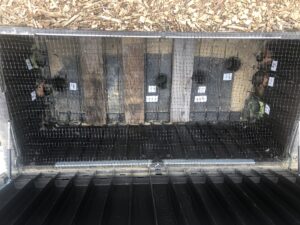
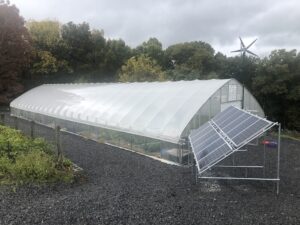
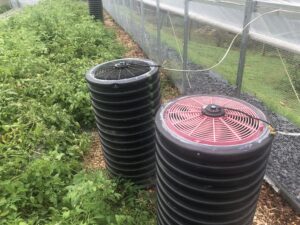
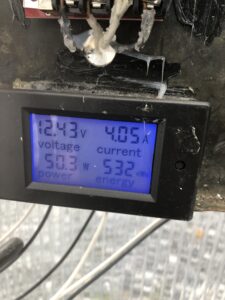
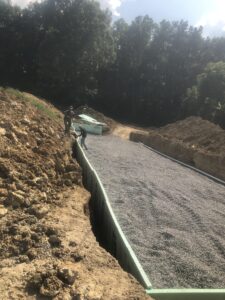
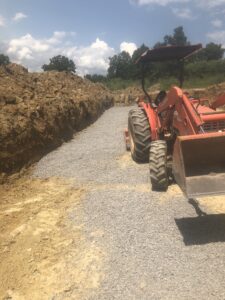
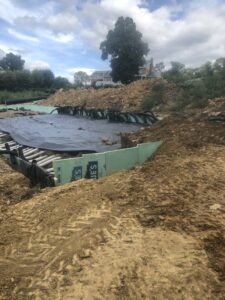
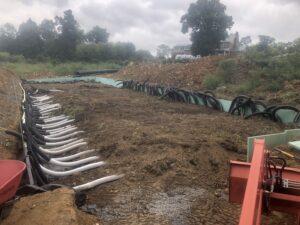
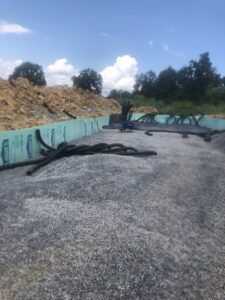
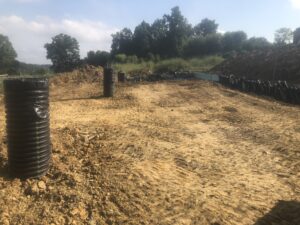
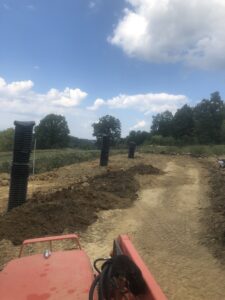

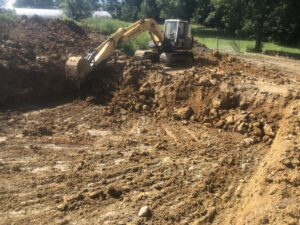
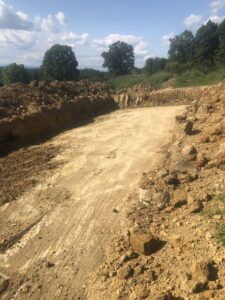
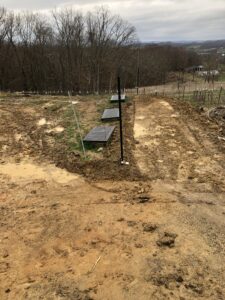
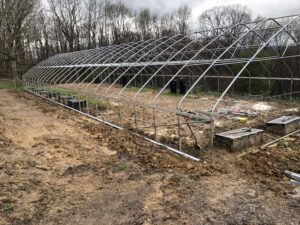
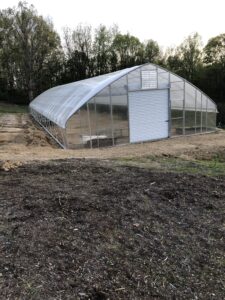
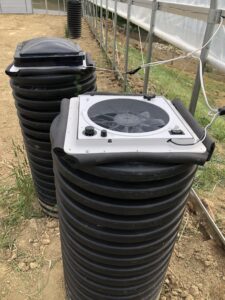
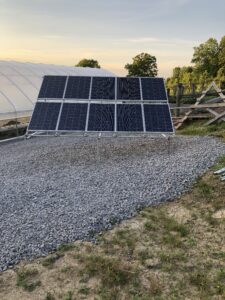
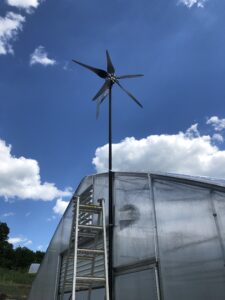
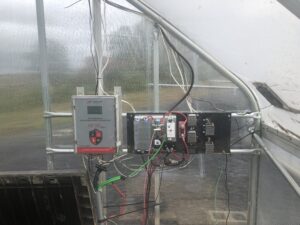
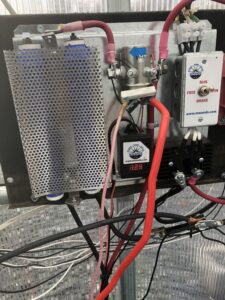

April 2020 – July 2021. Initially four 100 watt 920 CFM fans were installed to blow air through the geothermal pipes. After analysis of air flow, fans were upgraded twice, first set of four fans were 25 watt 920 CFM, then four fans 90 watt/2000 CFM and then to four 120 watt/3000 CFM fans. Four rheostats were installed to vary fans speeds. These devices also provided the exact wattage and amperage draw from the fans. Initially ten 100 watt solar panels, one 1600 watt Missouri Wind and Solar wind turbine and an all-in-one controller were installed. Two additional solar panels were added due to the increased wattage needed for testing. This was the maximin wattage limit for the wind and solar controller. Initially six 12 volt/150 AH Trojan deep cell lead acid batteries were installed. After analysis, two additional new batteries of the same brand were installed. After further analysis, six new hybrid gel Renogy 200 AH batteries were substituted. Also installed was an Advancing Alternatives controller that served to regulate the fans, raise and lower the side curtains and other functions unrelated to this project. Remote temperature gauges were installed, one for the control high tunnel (non geothermal) and one for the geothermal high tunnel and two outside the high tunnels. All these components were in place by January 2021. Up until that time, hundreds of tests were done to determine the optimum methodology and component configuration. Beginning in early January 2021, testing with the new components began utilizing the following revised procedure: The geothermal fans would run for at least four hours during the daylight hours. With the side wall curtains closed at night on the control and geothermal high tunnels, fans in the geothermal high tunnel were set at one of three speeds. These speeds of all four fans together ran at either 100, 200 or 300 watts with the corresponding CFM of 2500, 5000, 7500 respectively. Note that despite each fan having a 120 watt rating, the highest actual wattage that each fan ran was about 75 watts for a total of 300 watts for all four fans. During winter nights when the temperature was below 40 degrees, temperature data for the control and geothermal high tunnels were recorded at four different times (early evening, midnight to 2:00 AM, 4:00 to 6:00 AM and at sunrise (collectively called measurement periods). There were at least five measurement periods for each of the fan velocities (100, 200, 300 watts). Thus a total of at least 15 nights (four times a night) of measurement periods were be made during the winter 2021 months.
During the summer 2021 day time, the procedure was as follows: when the temperature in the high tunnels exceeds 75 degrees, the actual temperature within the high tunnel was recorded and the temperatures at each of the four air exiting manifolds were recorded. This process was repeated at different times of the day for at least five testings. The sides of the geothermal high tunnel had to remain open at all times of the day and night because it was found that with them closed during a sunny day the high tunnel temperature will easily exceed 100 degrees.
March 2021 – Relative materials and operating costs for three types of technologies to heat similar size high tunnels were calculated and recorded. The three are: 1. a non self-sustaining (powered exclusively by electricity with no wind turbine or solar panels) geothermal high tunnel, 2. a self-sustaining geothermal high tunnel (solar panels, wind turbine, batteries with or without electrical backup) and 3. a natural gas/propane high tunnel.
January 2020 – July 2021 – Analysis of the data and conclusions were made and submissions for presentations developed and made. Presentations and farm visits were conducted within COVID 19 guidelines. A pre-experiment presentation was made at the 2020 West Virginia Small Farm Conference. A second presentation was made at the virtual 2021 West Virginia Small Farm Conference. Presentations were also made to visitors to our farm, to four classes of West Virginia School of Osteopathic students and faculty for its Culinary Science program and a YouTube Video was filmed by the West Virginia Extension Service and is to be posted. A virtual SARE farm tour in 2021 also included the geothermal high tunnel.
July 2021 - August 2021 – Preparation of report to be submitted to SARE.
The following was measured, observed and discovered in this project:
Experimental design: It became apparent that the original experimental design would not work during summer days. This is because the passive solar heating from an enclosed high tunnel (sides down) made measuring the effect of geothermal cooling impossible. With the sides down during sunny days the temperatures in high tunnels rose quickly and exceeded 100 degrees. Thus, there could be no comparison during the day between the control high tunnel and the geothermal high tunnel. With the sides open on the geothermal high tunnel, temperature measurements were made at each of the 90 exit points of the pipes and these temperatures were lower than the temperature in the high tunnel, but there was no way to determine if this had any real effect on cooling the high tunnel, since the sides were open and the cool air quickly dissipated. Other tests were made with the sides open and the temperature of the high tunnel compared to the temperature exiting the four manifolds. This was accomplished by reversing the direction of the fans so air was pulled from the 90 underground pipes and exited at the four manifolds instead of being pushed through the manifolds and exiting the 90 pipes. These measurements from the four manifolds were all consistent with each other and during the summer ranged in the low 70’s with the temperature in the high tunnel ranging from 83 to 96 degrees after multiple measurements. This data clearly demonstrates that the pipe ground temperature and the air exiting temperature was much cooler than the high tunnel temperature, but with the sides open this cooling did not have a material effect on the high tunnel overall internal temperature. It is likely in a fully insulated greenhouse the geothermal air would be able to mitigate the heat generated from the sun, but not in a thin double layered plastic covered in our high tunnel. Regardless of the outcome of the experimentation, the fans do provide air circulation. Air circulation is helpful to plant growth and disease prevention.
Experimentation during the winter, arguably the most critical time to address temperature control, was much more positive. Initially the experimentation was to focus on measuring the temperatures in each of the 90 geothermal pipes. Temperatures in the pipes vary and this data did not address the principal purpose of the project, i.e. whether a high tunnel can be heated sufficiently using a geothermal system powered by wind, solar and battery energy. The new experimental design provided useful data necessary to report valuable findings. It was found after multiple measurements made at temperatures below 40 degrees and at times well below 20 degrees that the geothermal system was able to warm the high tunnel to above freezing until the temperature neared 22 and then at least ten degrees higher than the outside temperature (and control high tunnel temperature) when those temperatures were at 22 or below, provided the fans were running at about 300 watts (7500 CFM). It was also found that the wind, solar, battery with electrical backup system could adequately power the fans that provided air flow through the geothermal pipes and into the high tunnel. It was further found that the optimum air speed to maintain the highest temperature during the winter months was at 300 watts or about 7500 CFM and the optimum configuration was ten to twelve 100 watt solar panels, one 1600 watt wind turbine, 6 Renogy 200AH hybrid gel batteries and a electrical backup (see discussion below). Finally, it was found that wind was not a dependable source of energy in our location because the wind speed was not sufficient on most days to generate sufficient energy, but that solar was efficient in generating energy and was on most days a reliable source of energy (see below for more explanation).
Solar panels and wind energy: As stated above solar panels during the day produce significantly more energy (measured in watts) than the wind turbine, except when there is heavy overcast and there was significant wind (at least 15 to 20 miles per hour). Neither produce the wattage specified in their rating (a total of 1200 watts for 12 solar panels and 1600 for wind), but solar is much more efficient. Of course, at night when the wind is blowing in excess of 15 mph, there is wind energy and no solar energy being produced. But unless the geothermal high tunnel is located in a high and consistent wind area, the readings demonstrate solar is much more efficient. During an extended time when there was significant overcast during the days and no significant wind day or night, the batteries began to fall below the 50% charge threshold and it was necessary to either recharge them or utilize an electrical backup to power the fans. The configuration of solar panels, wind turbines and batteries needed to keep the recharging at a minimal is 10 to 12 solar panels, one wind turbine and six 200 Ah hybrid gel deep cell batteries. We will discuss in detail solar panels, wind turbines and batteries below as well as electrical backup capabilities.
Fans: The fans have been a challenge in the experimental design. Originally, four fans, each at 25 watt, 920 CFM each, were installed. However, the air flow from the geothermal pipes was minimal and utilizing these fans would not provide strong enough CFM to positively affect air temperature. Therefore higher velocity fans were utilized at 90 watts each. However, these fans ran significantly below 90 watts. While these fans did increase the air flow, it was decided to ultimately install use four 120 watt radiator fans (3000 CFM each). These fans ran at 75 watts (1875 CFM) each.
Batteries: Originally six standard deep cell 150 Ah (amp hours) Trojan batteries were installed. These batteries were removed from a newly purchased ATV electric vehicle. Testing during the summer days indicated acceptable voltage rarely dropping below 50% of charge (12.4 volts). Lead acid 12 volt batteries can be damaged if the voltage goes below 50% charge. Testing during the late fall showed frequent voltage drop to impermissible levels. To remedy this, two additional Trojan batteries were purchased. This added an additional 300 Ah. As testing continued during the winter the batteries began to lose charge and on two occasions went dead. We believe this was due to the older batteries not being in good condition when purchased or not maintained properly after purchase. After research, we decided to purchase Renogy deep cell hybrid gel 200 AH batteries. We initially purchased 5 batteries but decided that a total of six would be needed to do this experimental testing at 300 watt draw. Hybrid gel batteries provide excellent performance and long life. Specifically, they are able to better withstand repeated charge discharge cycles. We calculated that six batteries were needed because this would allow for use of 600 Ah per cycle (50% of the 1200 total Ah). We ultimately determined the optimum speed (CFM) to provide the highest temperature increase during the winter to be about 300 watts. At 300 watts, six 12 volt batteries (total of 1200 Ah) should be able to run safely for 24 hours (watts = amps X volts) at 50% or greater without recharge. As the sun rises or if the wind blows, the batteries will recharge, especially since the fans do not need to run more than a 4-6 hours during the day. It should be noted that ultimately fewer batteries and lesser solar panels may be an acceptable configuration, but if we are to test up to 300 watts, we need the additional batteries and solar panels. Given the controller limitation, we can only have one wind turbine and 12 solar panels. It should also be noted that we did drop the wattage down to 280 to see if that made an appreciable difference in the high tunnel temperature and it did not. So we believe that 7500 CFM is about the correct air flow for this size high tunnel. We also believe that our piping configuration was overkill and that the ideal piping should have been three separate manifolds on each side with three fans that still would need to emit a total of 7500 CFM. There were research reasons we used four manifolds and fans, but we now believe three fans would suffice. Further, we only used manifolds on one side and left the 90 pipes connected to 9 separate collections centers on the other side of the high tunnel. This was done to allow us to do future specific research into the effect of pipe depth and ground composition and is unrelated to this project.
Controller: A controller is needed to be an interface between the solar panels, wind turbine and batteries. We chose the Missouri Solar and Wind “All in One” controller because it has a dump function to prevent overcharging and damaging the batteries and because it allowed up to 1200 watts of solar panels (twelve 100 watt panels) and a 1600 watt wind turbine. Other controllers we researched did not allow for both wind and solar energy. We also purchased an Advancing Alternatives controller that can automatically turn on and off the fans as well as control side curtains, side vents and other unrelated needs. The Advancing Alternatives controller is not critical for this project, but the equipment does help regulate temperature within the high tunnel. It should be noted that if the farmer wishes to utilize solar energy without wind turbine they can purchase an excellent and much less expensive controller from Windy Nation, another solar products company.
Testing: As stated above, testing has shown that the geothermal effect does moderate the temperature within the high tunnel during winter months and that fan velocity does affect the temperature. As expected, during the winter nights, the colder the outside temperature, the greater the temperature gap between the control/outside temperatures and the geothermal high tunnel. temperatures. Whether the temperature is moderated to a level acceptable to the grower will depend on the crops grown and the expectations of the farmer.
Other observations: It is highly recommended that either a backup electrical circuit or a battery changer be available to use in time during the winter when there is extended overcast and no appreciable wind for many days to protect the batteries from harmful discharge below 50%.
Batteries should be fully charged before initial use and should be adequately insulated from extreme heat and cold. We used a two inch insulated foam board on the top, bottom and sides of the batteries which seemed to work well.
We had always understood that below 3-4 feet the ground temperature will remained at approximately 55 degrees. This may be true with ground that does not have 90 four inch perforated pipes running through it and insulation on its perimeter, but it was not true for our climate battery. We found that the ground temperatures were about 70 degrees during the summer and 40 degrees during the winter. This is why it is important particularly during the winter to run the geothermal fans during the day when the high tunnel is warm so that the heat will warm the underground soil temperature for the night running. And this is also why the colder it gets outside the more the 40 degree heat from the geothermal heated ground will moderate the temperature within the high tunnel at night. Climate batteries are not the same as traditional geothermal. Climate batteries are like any other battery, they are charged by an external force, in this case warm air collected and stored in the ground during the day and then released at night to warm the high tunnel.
As noted above, this project sought to discover if a geothermal high tunnel powered by self-sustaining solar/wind energy is a viable option for farmers wanting to farm year-round in climates susceptible to extreme hot and cold temperatures. We found that overall utilizing geothermal energy and powering it with wind energy is a viable option for farmers. Below we will address each sub objective and our findings:
In studying this objective, this project sought to determine the following:
- Whether a self-sustaining geothermal solar/wind energy system can “sufficiently heat” a geothermal high tunnel when the control high tunnel temperatures are below 40 degrees without a supplemental heat source such as natural gas. “Sufficiently heat” is defined as maintaining the geothermal high tunnel temperature above freezing at night when the control high tunnel temperature is 22 degrees or above; and maintaining the geothermal high tunnel temperature at least ten degrees higher when the control high tunnel temperature For this sub-objective, we found that the geothermal system was effective during the winter months to help warm the high tunnel to temperatures above freezing when a second "control high tunnel" temperatures were 22 degrees or above and maintained the geothermal high tunnel at least ten degrees warmer than the "control high tunnel" when temperatures were below 22 degrees. In cases where we anticipated severe temperatures below 22 degrees in the control high tunnel, we were able to protect our crops using the geothermal warming and Agri-bon frost protection fabric.
- Whether a self-sustaining geothermal solar/wind energy system can “sufficiently cool” a high tunnel during temperatures above 75 degrees with side curtains closed and if so, can it do so for extended periods during the hot summer months in West Virginia. “Sufficiently cool” is defined as maintaining the temperature in the geothermal high tunnel at 75 degrees. For this sub-objective, we also conducted research on the effect of geothermal system in the summer but quickly found that there was no way to accurately measure the temperature differential because the high tunnel side curtains were required to be open to prevent the solar effect from the sun from overheating the high tunnel. We did determine, however, that the air emanating from the pipes in the geothermal high tunnel was significantly cooler than the temperature within the high tunnel itself, demonstrating cool air was being added to the high tunnel. We also found that the fans were helpful in circulating the air within the high tunnel, thus preventing air stagnation.
- The optimum design configuration for such a system in terms of solar, wind turbine and battery interface and electrical backup. For this sub-objective, we found a design of four high speed fans powered by twelve solar panels, a wind turbine and six 200Ah hybrid gel batteries with an electrical backup was workable. We do believe however that three more powerful fans that will equate to the 7500 CFM output, a slightly different more simplified underground pipe design, and ten solar panels would be optimum. Further, we believe at least in our area of West Virginia that wind energy is not justified. See Results and Discussion above and Assessment of Projects Approach and Areas of Further Study below.
- The relative materials and operating costs of traditional geothermal, self-sustaining geothermal, and natural gas/propane systems both in start-up and annual operating costs. We have included in the Project Outcomes below a detailed breakdown on the materials and operating costs of each component of this project and an estimate of the costs for natural gas/propane system.
- Whether the sides of a high tunnel should be open or closed when cooling the high tunnel in the summer using geothermal energy. They must be open to avoid overheating the high tunnel during the summer and most other times during the year except during cold cloudy days and cold nights.
- The optimum fan air velocities (measured as cubic feet per minute) in the underground pipes to effectively transmit and moderate the heating and cooling in a large high tunnel. We found that about 7500 CFM (running at 300 watts) provided optimum air transfer to heat our large high tunnel.
Education & Outreach Activities and Participation Summary
Participation Summary:
Richard and I have presented our SARE grant twice at the West Virginia Small Farm Conference; once to a live audience and then during a virtual format due to COVID-19 restrictions. The participants at the Small Farm Conference were farmers throughout our state, WVU professors, NRCS and USD employees and local citizens. Throughout the past two years we have also had six farm tours at our farm where we discussed our project with local farmers and students at the WVSOM school of medicine. Our farm is part of the Culinary Science course at the WVSOM school where medical students learn about nutrition and how food is grown. Geothermal High Tunnel.updated export to pdf.
This project was also discussed in a video about our farm as part of the Farm to Plate in the Mountain State, created by West Virginia State University for Northeast SARE: https://youtu.be/Dt3EL0IVFC8.
Learning Outcomes
Through questions and answers provided at the WV Small Farm Conference, during our farm tours, along with online presentations farmers indicated interest and understanding of a geothermal systems powered by alternative energies.
Project Outcomes
Below we have listed a number of project outcomes:
Geothermal
- Successfully installed and operated a geothermal climate battery high tunnel system powered by wind, solar, battery and electrical backup to help mitigate temperature extremes in the high tunnel particularly during cold winter months.
- Created an optimum design for a geothermal high tunnel system in a large high tunnel. Specifically, three 30 ft manifold pipes on each side of the high tunnel connect to 90 four inch perforated pipes at two levels at three and five foot depth and two foot width apart (45 pipes at each level). On one side of each manifold pipe there is a vertical manifold pipe connected by a 90 degree pipe connector and on the other side a cap. On the top of three vertical manifolds on one side are the fans and on the other side the manifolds are left open.
- Discovered the optimum fan speeds are closer to a total of 7000 to 8000 CFM which is much faster than previous research indicated.
- Used internal pipe connectors to connect pipes to manifolds making it easier and more secure to attach.
- After experimenting with various 12 volt fans, used four 120 watt 12 volt radiator fans which operate at optimum air flow of a total of 7500 CFM (300 watts).
- Learned that in a climate battery, a deeper pipe depth had no significant advantage. Pipes 3 ft or deeper provide similar temperatures as those 7 to 8 ft.
- Discovered underground air temperature is not constant but vary throughout climate changes.
- Learned that it is important during the winter to run fans at least four hours during the heat of the day to raise the underground temperature for night heating.
- Found that winter underground temperature is normally in the low 40s degrees and summer temperature in the low 70s.
- Discovered during the winter, the lower the outside temperature the greater the degree differential between the outside/control high tunnel and the geothermal high tunnel.
- Learned that drainage pipe which was installed kept almost all the water out of the underground pipes and manifolds
- Found that the effect of geothermal cooling during the summer is nominal because the sides of the high tunnel must remain open to prevent overheating within the high tunnel and the cool air dissipates. The geothermal fans do provide ventilation.
- The estimated equipment and materials costs for a geothermal system are as follows:
- Manifolds: 14 18 inch culvert pipes - $3602
- Six 90 degree 18 inch pipe connectors - $1338
- Six end caps - $442
- 30 100ft four inch perforated sleaved pipes - $1911
- 32 two inch insulation foam boards - $1166
- Three 120 watt 12 volt radiator fans - $150
Total materials and equipment for geothermal $8609 Note this not include labor or excavation costs. These are current prices. There should be no additional annual costs after setup costs.
Solar
-
- Learned that solar panels should be as close as possible to controller to decrease voltage/wattage loss.
- Designed and built an adjustable solar frame to adjust to optimum angle based on time of year (15 degrees plus latitude in winter, 15 degrees minus latitude in summer. Panels point south direction.
- Discovered solar panels generate reliable high amount of wattage on sunny and partially sunny days and lower but still reliable wattage on overcast days. Much more efficient than wind energy.
- Ten to twelve solar panels with batteries are sufficient to power 300 watts draw from fans in most cases with electrical backup when needed.
- Found that in winter when there are overcast conditions and no wind energy generated for consecutive days, electrical backup or battery charging is necessary to avoid depletion of batteries.
- Discovered steeper sloped solar panels during winter not only generates more energy but also helps shed snow from panels.
- Learned heavy gage wire is necessary to connect solar panels to controller and that solar panels should always be located as close as possible to the controller.
- Estimated costs of materials and equipment for Solar –
- Ten Solar Panels - $800
- Solar connectors and wire - $100
- Charge controller if not using wind turbine - $51
- Pipe frame total - $492.50
- 15 metal 10 ft pipes ($261)
- 6 bags of concrete ($31.50)
- Pipe hardware and bolts ($100)
- Optional winch and wire ($100)
Total initial solar costs without wind turbine add on - $1443.50
There should be no annual costs after setup for the life of the solar panels (estimate 15 years).
Wind
- To state the obvious, the key to wind energy is steady high winds. The winds in our location of West Virginia do not justify wind turbine addition. Wattage from a 1600 watt wind turbine based on wind speed are specified as follows:
-
- 12 mph – 100 watts
- 20 mph – 200 watts
- 40 mph – 600 watts
- 55 mph – 1600 watts
-
2. There were times particularly in the Spring and Fall where winds generated enough energy to produce 200 to 300 watts for a sustained period of time. The combination of solar and wind will generate enough energy to power the fans during night and day with battery backup, except when there is sustained cloudiness and little or no wind. In such case the batteries charge will fall below 50% and could damage the batteries. It is best to have an electrical backup or remote charger in such case. See below for electrical backup discussion.
3. In order to maximize wind turbine efficiency there should be no turbulence. This means there should be an unobstructed path from the blowing wind to the wind turbine. Trees, buildings, etc. should not be in the winds path. This may require placing the wind turbine on a very high pole. Our high tunnel was located on the top of a mountain and was placed on a 20 ft pole, but for others to avoid wind turbulence (obstructions in wind path) the pole may need to be much higher.
4. Wind turbines require a separate type of controller. Missouri Wind and Solar provided a combination solar and wind controller with a feature to protect the overcharging of the batteries when the wind and/or solar exceeds about 14.2 volts.
5. Wind turbines generate alternating current whereas solar panels generates direct current. The combination wind/solar charger converts the energy to direct current and regulates the amount of voltage so as not to overcharge the batteries.
6. Estimated costs for wind energy are as follows:
-
- Missouri Wind and Solar all in one controller, 1600 watt wind turbine and wire $960.
- 20 ft mounting pole and concrete $125
Total setup estimate for wind energy is $1085. There should be little or no annual costs after setup for life (unknown) of wind turbine
Batteries
- Batteries are necessary if relying on solar or wind to provide energy for the fans.
- We originally used six and then eight Trojan deep cell 150 AH batteries and found them insufficient for our needs, discharging quickly when power was drawn overnight. Eight 150 AH batteries should last at least 24 hours before falling below 50% charge. They did not. The formula is Watts = Volts X Amps. Batteries should never be run below 50% charge. Testing of the Trojan batteries we used showed significant drain below 50%. We then purchased six 200 AH Renogy hybrid gel deep cell batteries. These batteries with the same rated total amp hours of 1200 Ah lasted longer with less draw below 50%. This difference could be due to the quality of the battery, gel vs standard flooded lead acid or that the Trojan batteries were older and may have partially sulfated. Our customer service experience with Renogy was much more positive than that of Trojan.
- Renogy hybrid gel batteries are rated to last 12 years or 750 discharges at 50%. To avoid allowing a 50% discharge in overcast days with little or no wind we added an electrical back up (see next section)
- To retain 12 volt level each battery positive will need to be connected to the positive pole of the next battery and each negative pole to a negative of the next battery. This is called linking the batteries in parallel. This will provide a total of 1200AH for six batteries at 12 volts (actually 12.8 volts at full charge.)
- We learned that hybrid gel batteries are at full charge at 12.8 volts and at 50% charge at 12.2 volts.
- We learned that it is important to charge the batteries to full charge before connecting in parallel and to use no. 4 battery cables to connect the batteries to each other in parallel and to the controller.
- We also learned that to keep the batteries protected from the cold they should be insulated. We used two inch foam board around the top, bottom and sides of the batteries to provide adequate insulation.
- We learned that batteries should all be of the same brand and kind and should never be mixed with older batteries or batteries of a different kind and brand.
- We found and strongly recommend getting seal batteries so that constant maintenance is eliminated. Our initial Trojan batteries were not sealed and required periodic checking of water levels to avoid the battery becoming sulfated.
- Estimated costs: Battery costs depends on the quality and type of the battery. There are standard flooded lead acid batteries, AGM, gel and lithium batteries currently on the market. Lithium are clearly the best but can run as much as four times the cost of gel batteries when comparing amp hours. We used hybrid gel batteries which we believe are the second best and run about $450 per battery from Renogy in current prices. Six batteries will provide 1200 Ahs which should sustain the batteries at 50% for much of the winter without an external recharge from electricity or a battery charger. Add $73 for insulating boards and the total for battery setup is: $2773 at current prices. There are no continuing costs after the initial setup costs until the batteries die. Gel batteries are advertised at 12 years or 750 discharges at 50% or below.
Electricity
-
- On grid electricity can be used as a backup during winter days without full or partial sun and no wind or to directly energize the fans with no alternative energy utilized. Of course there must be grid power connections available to utilize the grid. Assuming the farmer wants supplement the alternative energy, electricity can easily be converter from 120 volt AC to 12 volt DC with a converter for about $40 plus any wiring costs. The annual costs of using the electrical backup depends on the number of days where there is not enough sun or wind to generate sufficient battery charging to run the fans at night. We estimate this will occur only 10 to 20 days during the winter and the electrical cost will be de minimis.
- Looking at current electrical rates, should the farmer wish to run the fans (total of 300 watts) solely with electricity (no alternative energy) the annual electrical cost is estimated to be about $400. There would be wiring costs to connect the fans to the electric source and this would depend on the location of the closest electric connection device.
Using natural gas or propane to heat a 30 x96 ft high tunnel
-
- Farmers who wish to heat their high tunnels with gas or propane should expect the following costs: Estimated retail cost of two 175,000 BTU Renzor gas furnaces with stainless steel heat exchangers is about $5200. Installation estimated at least $1000.
- Estimated annual natural gas cost for 90 days, 12 hours a day is $5,560 and for propane $12,867. *Note these costs do not include the costs to ventilate a high tunnel during other months of the year
Summary observations:
-
-
-
- After installation costs, geothermal heating and ventilating (with or without alternative energy to run the fans) has virtually no annual costs and is highly preferable to the traditional heating of high tunnels with propane or natural gas.
- While there may be times in extreme cold weather days where the farmer will want to further protect the crops with Agribon or other row cover, the geothermal heating in our experiment kept temperatures above freezing in the geothermal high tunnel when control high tunnel temperatures were 22 and above. The temperature differential between the control temperatures and the geothermal high tunnel temperatures increased the colder the control high tunnel temperature got. In order to obtain this differential the fans needed to run at a total of about 300 watts which equates to about 7000 to 8000 cubic foot per minute (CFM).
- While our geothermal design was slightly different than what we recommend above, we believe our recommended design that has the same number of underground pipes will be as effective, easier and less expensive to install.
- Given the wind speed necessary to generate energy, it is not recommended the farmer use wind turbines unless the farmer lives in an area with significant and steady wind.
- If there is not significant and steady wind, we recommend the use of solar energy with batteries and electrical backup as the sources of energy to run the fans of the geothermal system.
-
-
As stated previously, the entire project was a learning experience in which we discovered by experimentation what worked, what could be improved and what failed. Specifically, we found that the design of the geothermal high tunnel could have been improved by utilizing three separate manifolds along each long (curtain) side of the high tunnel instead of our four manifold system with the sections of pipes in different orientations. This would have saved a lot of work as it would have made it easier to cover each section of pipes with the substrate and more evenly distributed the pipes. We believe that three instead of four manifolds on each side would have saved pipe and fan expense and yet still easily distributed air flow. We found that the use of internal couplings was a huge savings in time and effectiveness of installation. We found we needed additional number and types of batteries and that an electrical backup system could help keep the batteries from repetitive discharges at 50% or more thus extending the life of the batteries. We found that air speed through the geothermal underground pipes needed to be much higher than as indicated in previous research ny others. We found that wind energy requires living in a high wind area, which excludes much if not all of West Virginia. These and other revelations could only be discovered through trial and error and from that standpoint our approach was sound. We hope that others will learn from our research and utilize our recommended geothermal system and configuration (absent wind turbine) design.
There were six specific objectives contained in our plan of work. Of those, we were able to answer four and one half through data analysis and/or experiments. Specifically, we found a self-sustaining geothermal high tunnel could sufficiently heat a large high tunnel during temperatures below 40 degrees for several days without a supplemental heating source, although in extreme cold below 24 degrees it was necessary to cover the plants as well. We provided an optimal design configuration of wind turbine, solar and batteries (one 1600 watt turbine, ten to twelve 100 watt solar panels and six 200Ah hybrid gel batteries), although we believe wind energy is unrealistic for geothermal in our area. We provided relative materials and operating costs of a traditional (without alternative energy), self-sustaining geothermal and the proposed cost of using natural gas heater. We found that the long curtain sides should remain open even with the geothermal system operating at full speed to prevent extreme temperature increase from sun heating. We determined the optimum air speed range in CFM for heating. Regarding the air speed for cooling as noted below, we could not accurately determine cooling CFM due to the heat produced by the sun offset the cooling. We found that while it is certain that geothermal fans provided important air circulation during the summer months, there was no objective way to measure the effect of the geothermal cooling within the high tunnel other than by showing the temperature differentiation between the air exiting the manifolds and the air in the high tunnel remote from the manifolds and thus no objective way to calculate optimum CFM for cooling. It should be noted that while cooling high tunnels through geothermal was part of our study, the main focus was whether geothermal high tunnels using alternative energy were a benefit during the winter growing season and to that area of inquiry, we can answer most affirmatively that it is a benefit and one of relatively low-cost. Comparing our highly productive strawberry growth during the winter months in the geothermal high tunnel with an adjacent outside strawberry bed demonstrated the positive effect of the geothermal heating on plant growth.
Regarding additional work on the topic, we actually designed the geothermal high tunnel underground piping so that we could test additional areas of inquiry including (1) the difference in underground heat retention , if any, between pipes buried in gravel and those in soil and (2) whether the depth pipes placed in the ground would affect the temperature of the air coming out of the pipes. We believe further research should be done to address these related areas.
Lastly, we believe any farmer who grows or wishes to grow in cold climates that require high tunnels might greatly benefit from our research.
